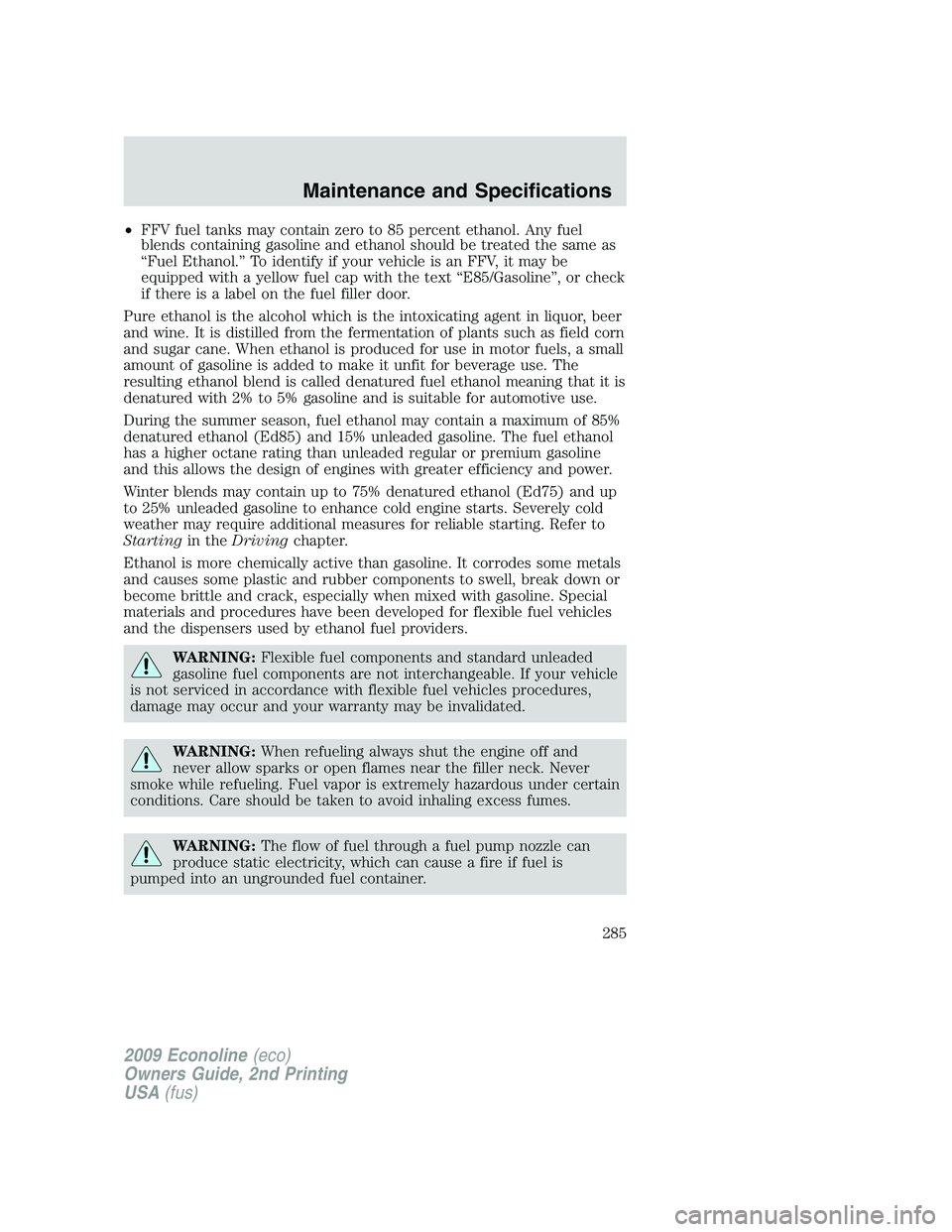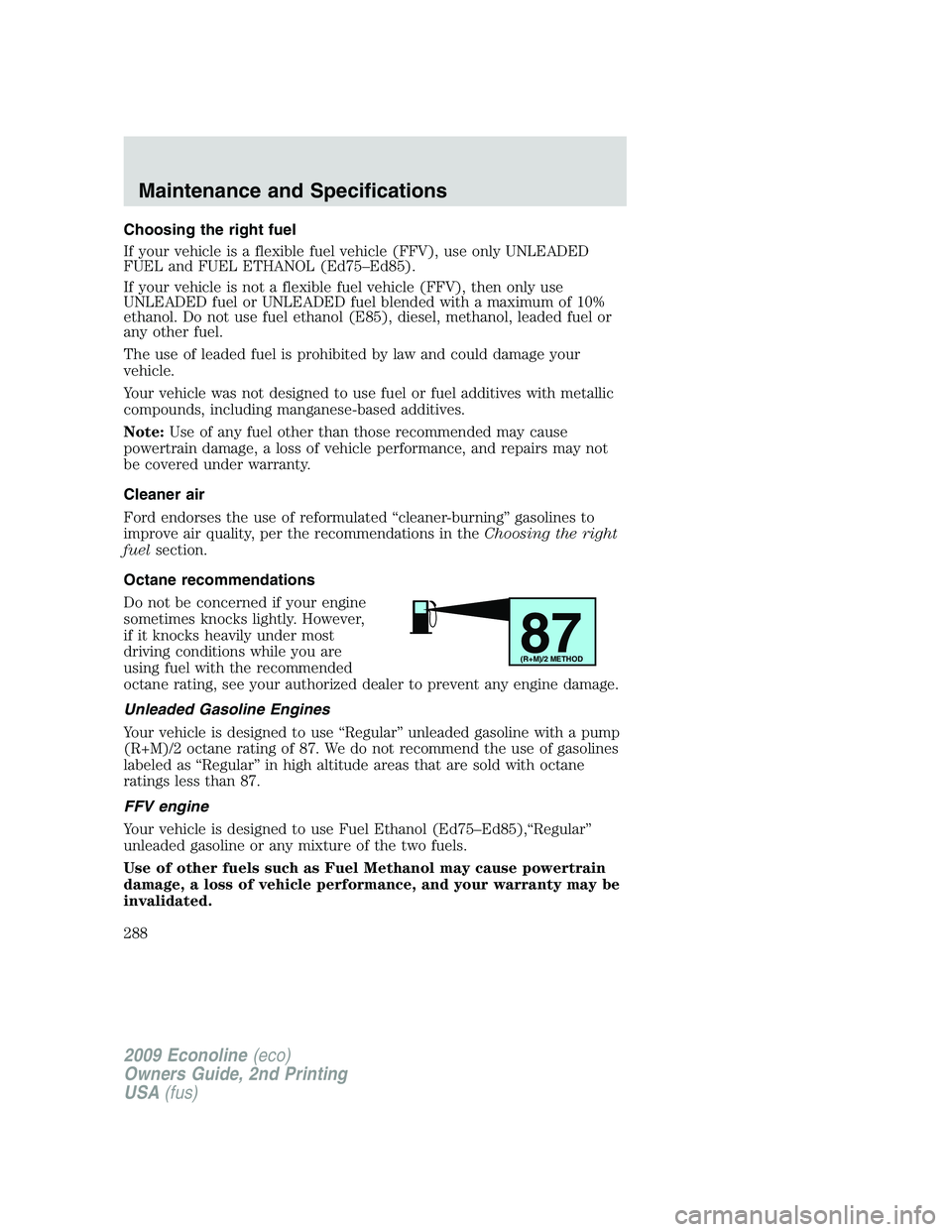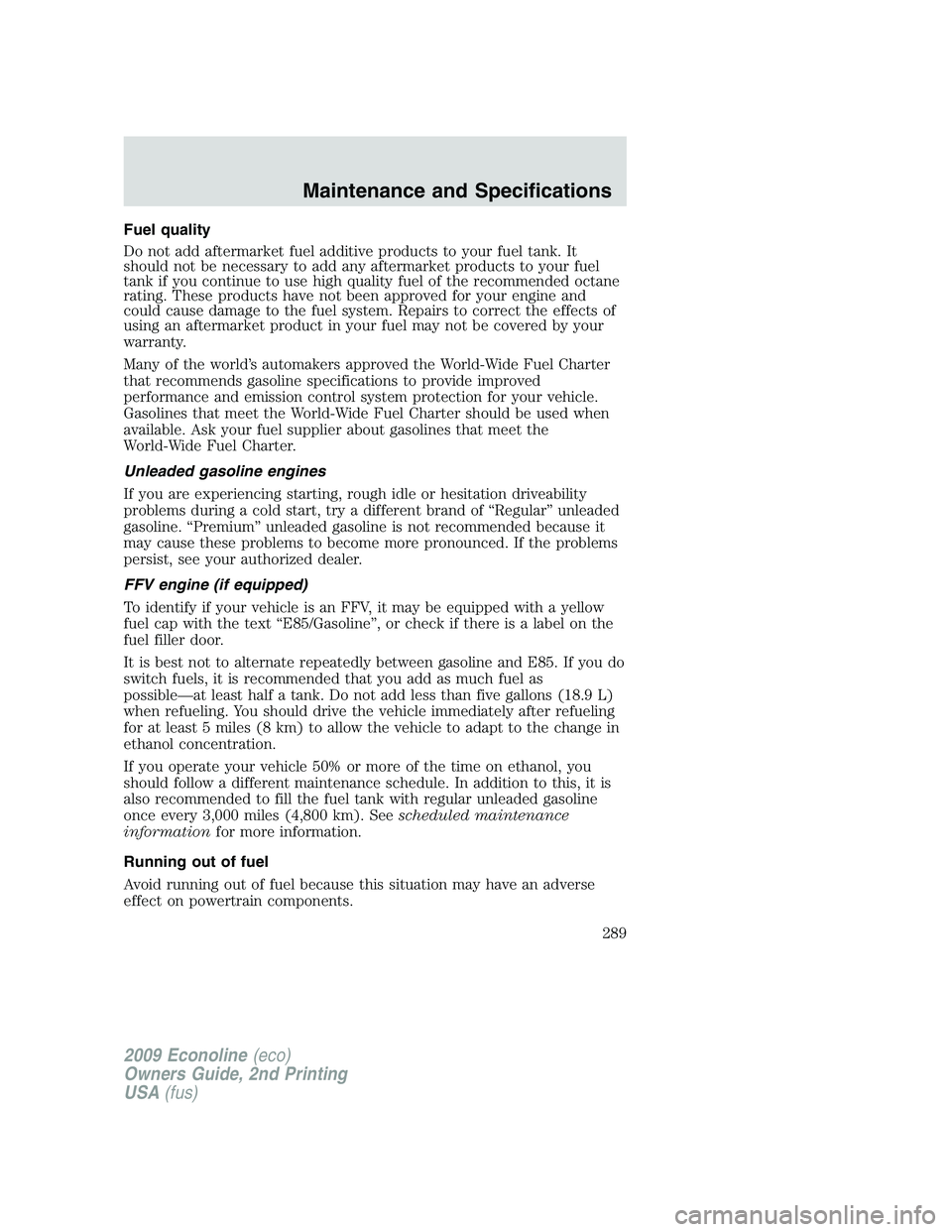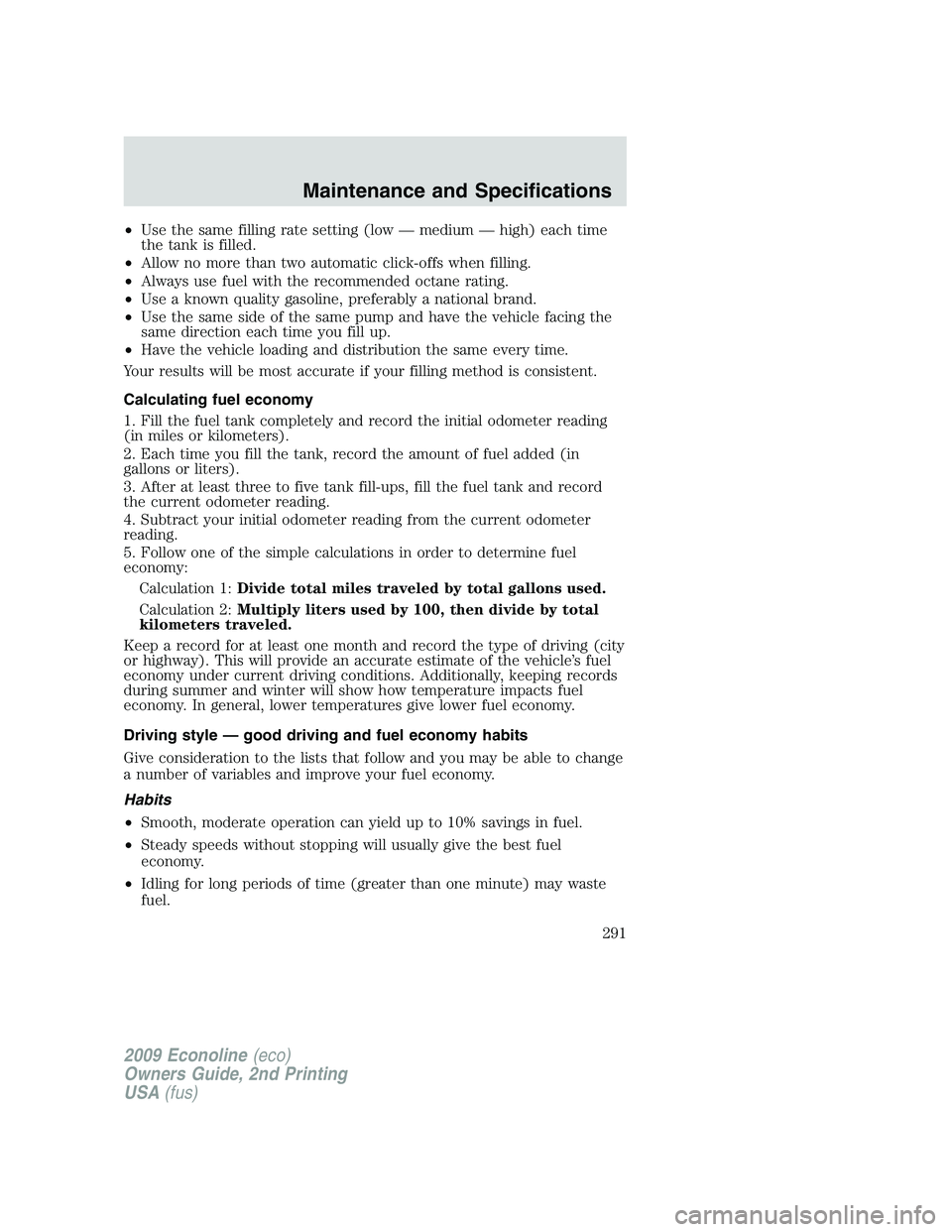2009 FORD E450 octane
[x] Cancel search: octanePage 285 of 320

•FFV fuel tanks may contain zero to 85 percent ethanol. Any fuel
blends containing gasoline and ethanol should be treated the same as
“Fuel Ethanol.” To identify if your vehicle is an FFV, it may be
equipped with a yellow fuel cap with the text “E85/Gasoline”, or check
if there is a label on the fuel filler door.
Pure ethanol is the alcohol which is the intoxicating agent in liquor, beer
and wine. It is distilled from the fermentation of plants such as field corn
and sugar cane. When ethanol is produced for use in motor fuels, a small
amount of gasoline is added to make it unfit for beverage use. The
resulting ethanol blend is called denatured fuel ethanol meaning that it is
denatured with 2% to 5% gasoline and is suitable for automotive use.
During the summer season, fuel ethanol may contain a maximum of 85%
denatured ethanol (Ed85) and 15% unleaded gasoline. The fuel ethanol
has a higher octane rating than unleaded regular or premium gasoline
and this allows the design of engines with greater efficiency and power.
Winter blends may contain up to 75% denatured ethanol (Ed75) and up
to 25% unleaded gasoline to enhance cold engine starts. Severely cold
weather may require additional measures for reliable starting. Refer to
Startingin theDrivingchapter.
Ethanol is more chemically active than gasoline. It corrodes some metals
and causes some plastic and rubber components to swell, break down or
become brittle and crack, especially when mixed with gasoline. Special
materials and procedures have been developed for flexible fuel vehicles
and the dispensers used by ethanol fuel providers.
WARNING:Flexible fuel components and standard unleaded
gasoline fuel components are not interchangeable. If your vehicle
is not serviced in accordance with flexible fuel vehicles procedures,
damage may occur and your warranty may be invalidated.
WARNING:When refueling always shut the engine off and
never allow sparks or open flames near the filler neck. Never
smoke while refueling. Fuel vapor is extremely hazardous under certain
conditions. Care should be taken to avoid inhaling excess fumes.
WARNING:The flow of fuel through a fuel pump nozzle can
produce static electricity, which can cause a fire if fuel is
pumped into an ungrounded fuel container.
2009 Econoline(eco)
Owners Guide, 2nd Printing
USA(fus)
Maintenance and Specifications
285
Page 288 of 320

Choosing the right fuel
If your vehicle is a flexible fuel vehicle (FFV), use only UNLEADED
FUEL and FUEL ETHANOL (Ed75–Ed85).
If your vehicle is not a flexible fuel vehicle (FFV), then only use
UNLEADED fuel or UNLEADED fuel blended with a maximum of 10%
ethanol. Do not use fuel ethanol (E85), diesel, methanol, leaded fuel or
any other fuel.
The use of leaded fuel is prohibited by law and could damage your
vehicle.
Your vehicle was not designed to use fuel or fuel additives with metallic
compounds, including manganese-based additives.
Note:Use of any fuel other than those recommended may cause
powertrain damage, a loss of vehicle performance, and repairs may not
be covered under warranty.
Cleaner air
Ford endorses the use of reformulated “cleaner-burning” gasolines to
improve air quality, per the recommendations in theChoosing the right
fuelsection.
Octane recommendations
Do not be concerned if your engine
sometimes knocks lightly. However,
if it knocks heavily under most
driving conditions while you are
using fuel with the recommended
octane rating, see your authorized dealer to prevent any engine damage.
Unleaded Gasoline Engines
Your vehicle is designed to use “Regular” unleaded gasoline with a pump
(R+M)/2 octane rating of 87. We do not recommend the use of gasolines
labeled as “Regular” in high altitude areas that are sold with octane
ratings less than 87.
FFV engine
Your vehicle is designed to use Fuel Ethanol (Ed75–Ed85),“Regular”
unleaded gasoline or any mixture of the two fuels.
Use of other fuels such as Fuel Methanol may cause powertrain
damage, a loss of vehicle performance, and your warranty may be
invalidated.
87(R+M)/2 METHOD
2009 Econoline(eco)
Owners Guide, 2nd Printing
USA(fus)
Maintenance and Specifications
288
Page 289 of 320

Fuel quality
Do not add aftermarket fuel additive products to your fuel tank. It
should not be necessary to add any aftermarket products to your fuel
tank if you continue to use high quality fuel of the recommended octane
rating. These products have not been approved for your engine and
could cause damage to the fuel system. Repairs to correct the effects of
using an aftermarket product in your fuel may not be covered by your
warranty.
Many of the world’s automakers approved the World-Wide Fuel Charter
that recommends gasoline specifications to provide improved
performance and emission control system protection for your vehicle.
Gasolines that meet the World-Wide Fuel Charter should be used when
available. Ask your fuel supplier about gasolines that meet the
World-Wide Fuel Charter.
Unleaded gasoline engines
If you are experiencing starting, rough idle or hesitation driveability
problems during a cold start, try a different brand of “Regular” unleaded
gasoline. “Premium” unleaded gasoline is not recommended because it
may cause these problems to become more pronounced. If the problems
persist, see your authorized dealer.
FFV engine (if equipped)
To identify if your vehicle is an FFV, it may be equipped with a yellow
fuel cap with the text “E85/Gasoline”, or check if there is a label on the
fuel filler door.
It is best not to alternate repeatedly between gasoline and E85. If you do
switch fuels, it is recommended that you add as much fuel as
possible—at least half a tank. Do not add less than five gallons (18.9 L)
when refueling. You should drive the vehicle immediately after refueling
for at least 5 miles (8 km) to allow the vehicle to adapt to the change in
ethanol concentration.
If you operate your vehicle 50% or more of the time on ethanol, you
should follow a different maintenance schedule. In addition to this, it is
also recommended to fill the fuel tank with regular unleaded gasoline
once every 3,000 miles (4,800 km). Seescheduled maintenance
informationfor more information.
Running out of fuel
Avoid running out of fuel because this situation may have an adverse
effect on powertrain components.
2009 Econoline(eco)
Owners Guide, 2nd Printing
USA(fus)
Maintenance and Specifications
289
Page 291 of 320

•Use the same filling rate setting (low — medium — high) each time
the tank is filled.
•Allow no more than two automatic click-offs when filling.
•Always use fuel with the recommended octane rating.
•Use a known quality gasoline, preferably a national brand.
•Use the same side of the same pump and have the vehicle facing the
same direction each time you fill up.
•Have the vehicle loading and distribution the same every time.
Your results will be most accurate if your filling method is consistent.
Calculating fuel economy
1. Fill the fuel tank completely and record the initial odometer reading
(in miles or kilometers).
2. Each time you fill the tank, record the amount of fuel added (in
gallons or liters).
3. After at least three to five tank fill-ups, fill the fuel tank and record
the current odometer reading.
4. Subtract your initial odometer reading from the current odometer
reading.
5. Follow one of the simple calculations in order to determine fuel
economy:
Calculation 1:Divide total miles traveled by total gallons used.
Calculation 2:Multiply liters used by 100, then divide by total
kilometers traveled.
Keep a record for at least one month and record the type of driving (city
or highway). This will provide an accurate estimate of the vehicle’s fuel
economy under current driving conditions. Additionally, keeping records
during summer and winter will show how temperature impacts fuel
economy. In general, lower temperatures give lower fuel economy.
Driving style — good driving and fuel economy habits
Give consideration to the lists that follow and you may be able to change
a number of variables and improve your fuel economy.
Habits
•Smooth, moderate operation can yield up to 10% savings in fuel.
•Steady speeds without stopping will usually give the best fuel
economy.
•Idling for long periods of time (greater than one minute) may waste
fuel.
2009 Econoline(eco)
Owners Guide, 2nd Printing
USA(fus)
Maintenance and Specifications
291
Page 309 of 320

ENGINE DATA
Engine14.6L V8 engine 5.4L V8 engine 6.8L V10 engine
Cubic inches 281 330 415
Required fuel87 octane or
(E-85)
287 octane 87 octane
Firing order 1-3-7-2-6-5-4-8 1-3-7-2-6-5-4-8 1-6-5-10-2-7-3-8-4-9
Ignition system Coil on plug Coil on plug Coil on plug
Spark plug gap0.052–0.056 inch
(1.32–1.42mm)0.051–0.057 inch
(1.29–1.45mm)0.052–0.056 inch
(1.32–1.42mm)
Compression
ratio9.4:1 9.0:1 9.0:1
1Refer to the6.0 and 6.4 Liter Power Stroke Direct Injection Turbo
Diesel Owner’s Guide Supplementfor diesel engine information.
24.6L V8 FFV engines only.
Engine drivebelt routing
•4.6L V8, 5.4L V8 and 6.8L V10 engines without A/C
2009 Econoline(eco)
Owners Guide, 2nd Printing
USA(fus)
Maintenance and Specifications
309
Page 317 of 320

Event data recording ....................6
Exhaust fumes ..........................196
F
Fail safe cooling ........................282
Flexible Fuel Vehicle (FFV) ....283
Fluid capacities .........................305
Four-Wheel Drive vehicles
preparing to drive your
vehicle .....................................207
Fuel ............................................283
calculating fuel economy .......290
cap ...........................................286
capacity ...................................305
choosing the right fuel ...........288
comparisons with EPA fuel
economy estimates .................293
detergent in fuel .....................288
filling your vehicle with
fuel ...........................283, 286, 290
filter, specifications ........283, 304
fuel pump shut-off switch .....226
improving fuel economy ........290
octane rating ...................288, 309
quality ......................................289
running out of fuel .................289
safety information relating to
automotive fuels .....................283
Fuel - flex fuel vehicle
(FFV) .................................283, 288
Fuses ..........................................228
G
Garage door opener ....................61
Gas cap (see Fuel cap) ............286
Gas mileage
(see Fuel economy) .................290Gauges .........................................19
H
Hazard flashers .........................226
Head restraints ...........................92
Headlamps ...................................47
aiming ........................................50
bulb specifications ....................53
daytime running lights .............47
flash to pass ..............................48
high beam .................................47
replacing bulbs .........................54
turning on and off ....................47
Heating
heater only system .............44, 46
heating and air conditioning
system .......................................45
Hood ..........................................269
I
Ignition ...............................193, 309
Illuminated visor mirror .............60
Infant seats
(see Safety seats) .....................124
Inspection/maintenance (I/M)
testing ........................................295
Instrument panel
cleaning ...................................265
cluster ........................................14
lighting up panel and
interior .......................................48
J
Jack ............................................235
positioning ...............................235
storage .....................................235
Jump-starting your vehicle ......245
2009 Econoline(eco)
Owners Guide, 2nd Printing
USA(fus)
Index
317
Page 318 of 320

K
Keyless entry system
autolock .....................................80
Keys .............................................90
positions of the ignition .........193
L
Lamps
bulb replacement
specifications chart ..................53
daytime running light ...............47
headlamps .................................47
headlamps, flash to pass ..........48
instrument panel, dimming .....48
interior lamps ...........................51
replacing bulbs .........................54
LATCH anchors .........................128
Lights, warning and indicator ....14
anti-lock brakes (ABS) ..........199
Load limits .................................170
Loading instructions .................176
Locks
autolock .....................................80
doors ..........................................80
Lubricant specifications ...........305
Lug nuts ....................................244
Lumbar support, seats ...............94
M
Message center ...........................71
warning messages .....................76
Mirrors ...................................65–66
automatic dimming rearview
mirror ........................................65
fold away ...................................67
side view mirrors (power) .......66Motorcraft parts ................267, 304
N
Navigation system .......................43
O
Octane rating ............................288
Oil (see Engine oil) ..................271
P
Parking brake ............................199
Parts (see Motorcraft parts) ....304
Power distribution box
(see Fuses) ...............................231
Power door locks ........................80
Power mirrors .............................66
Power point .................................63
Power steering ..........................206
fluid, checking and adding ....296
fluid, refill capacity ................305
fluid, specifications .................305
Power Windows ...........................64
Preparing to drive your
vehicle ........................................207
R
Radio ................................22, 24, 29
Recommendations for
attaching safety restraints for
children ......................................122
Relays ........................................228
Remote entry system .................84
illuminated entry ......................88
2009 Econoline(eco)
Owners Guide, 2nd Printing
USA(fus)
Index
318